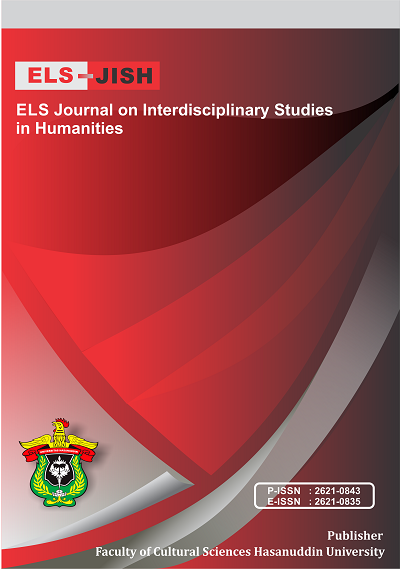Morphological Proses of Wolio Language in Kabanti Nuru Molabi
DOI:
https://doi.org/10.34050/elsjish.v4i1.13368Keywords:
Morphological process, Kabanti, Nuru MolabiAbstract
Morphology is the study of words and their structure. Morphological process is a mean of changing a stem to adjust its meaning to fit its syntactic and communicational context while morphological system of language reveals its properties trhough the morphemic structur of words. This research is aimed to elaborate the morphological system of Wolio language in Kabanti Nuru Molabi based on Anceaux theory. Kabanti is an oral tradition in literary works. Descriptive method is used to analyze this research. To do this research, the researchercollect the data from Kabanti Nuru Molabi text. Moreover, in this theory, Anceaux proposed and devided the morphological system based on the class of words. One same prefix is possible to make a different class of wordswhen it is attached to a verb or a noun. Anceaux classified the morphem based on the stem attached to verb or noun. Nevertheless, the data in Kabanti Nuru Molabi shows that suffix –na, to form a possessive, and suffix –mo to form demonstrative or affirmation are not covered in Anceaux.Downloads
References
Abas H, dkk (1983). Struktur Bahasa Wolio. Jakarta: Pusat Pembinaan dan Pengembangan Bahasa, Departemen Pendidikan dan Kebudayaan.
Abas H, dkk (1985). Kamus Wolio - Indonesia. Jakarta: Pusat Pembinaan dan Pengembangan Bahasa, Departemen Pendidikan dan Kebudayaan.
Aronoff and Fudeman (2011). What is Morphology: Second Edition. Blackwell: A John Wiley & Sons, Ltd., Publisher.
Anceaux, JC (1987). Wolio Dictionary (Wolio-English-Indonesia). Dordrecht: Foris Publication- Holland.
Anceaux, JC (1988). The Wolio Language: Outline of Grammatical Description and Texts. Dordrecht: Foris Publication- Holland.
Brown D. (1994). Principle of Language Learning and Teaching. USA: Prentice Hall Regents.
Finegan E. (2008). Language: its Structur and Use, Fifth Edition. United States of America. Michael Rosenberg.
Fromkin A.V (2000). Linguistics: An Introduction to Linguistic Theory. USA: Blackwell Publishers Inc.
Huluk C (2018). Semiotika Naratif Greimasian dalam Kabanti Bula Malino (master’s thesis). Fakultas Ilmu Dakwah dan Ilmu Komunikasi, UIN Syarif Hidayatullah, Jakarta.
Kracht M. (2018). Introduction to Linguistics. Los Angeles: Departmen of Linguistics, UCLA.
McCarthy (2002). An Introduction to english Morphology: Words and Their Structure. Edinburgh: Edinburgh University Press Ltd.
Mansyur, F. A., & Suherman, L. A. (2020). The Function of Proverbs as Educational Media: Anthropological Linguistics on Wolio Proverbs. ELS Journal on Interdisciplinary Studies in Humanities, 3(2), 271–286. https://doi.org/10.34050/els-jish.v3i2.10505
Niampe L. (2011). Bahasa Wolio di Kerajaan Buton. Linguistika, Vol. 18, No.34.
Niampe L. (1999). Kabanti Oni Wolio (Puisi Berbahasa Wolio). Jakarta: Pusat Pembinaan dan Pengembangan Bahasa, Departemen Pendidikan dan Kebudayaan.
Niampe L. (2000). Kabanti Oni Wolio (Puisi Berbahasa Wolio) Jilid II. Jakarta: Pusat Pembinaan dan Pengembangan Bahasa, Departemen Pendidikan Nasional.
Downloads
Published
How to Cite
Issue
Section
License
Copyright (c) 2021 Nurhayati Nurhayati

This work is licensed under a Creative Commons Attribution-NonCommercial-ShareAlike 4.0 International License.

















